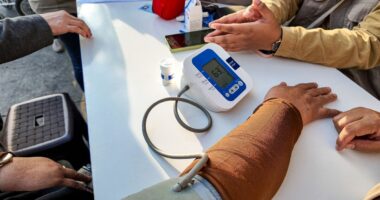Share this @internewscast.com
In a groundbreaking series of experiments, researchers are exploring innovative approaches that might revolutionize infertility treatments in the future.
Infertility impacts roughly 10 million American adults of reproductive age, with around 11 percent of women and nine percent of men experiencing this condition.
Nonetheless, pioneering research conducted at Oregon Health & Science University (OHSU) and published in Nature Communications holds promise for easing this challenge.
At OHSU, scientists successfully converted human skin cells into 82 eggs, which were then fertilized with sperm in a laboratory setting, leading to the creation of seven early-stage embryos. This achievement could open new doors to parenthood for individuals who struggle to conceive naturally.
This innovative technique involves reprogramming standard skin cells to become flexible, enabling them to transform into any type of cell in the body, including egg cells.
Such a method might overcome traditional reproductive hurdles by generating embryos without relying on conventional eggs, sperm, or invasive fertility procedures.
A woman’s ability to have a child declines with age, especially after her mid-30s, primarily because the number and health of her eggs decrease. Girls are born with around two million eggs. By age 37, the number drops to roughly 25,000.
And for women who have no viable eggs of their own, even standard fertility treatments like in vitro fertilization are not an option.

This technology could overcome basic biological limits, creating embryos without traditional eggs or sperm. For the first time, it could also allow same-sex couples to have a child genetically related to both parents (stock)
The ability to create an egg from a skin cell would allow an infertile woman to conceive, while men could use a skin cell to create an egg to be fertilized with their sperm and carried to term by a surrogate.
Dr Paula Amato, an obstetrics professor at the OHSU and study co-author, told Wired: ‘The obvious applications would be for older women who have run out of their own eggs or women who don’t have eggs for other reasons, such as previous cancer treatment or genetic abnormalities.’
Researchers recruited egg donors aged 21 to 35, resulting in 270 eggs, as well as sperm donors and donors for skin and blood.
To transform skin cells into eggs, scientists took the core of a skin cell, which holds all of its DNA, and transplanted it into a donor egg that had had its own core removed.
The egg was placed in what was left after the core was removed: the jelly-like filling that contains all the biological elements needed to create an embryo.
The final product was a lab-made egg that functioned like a natural one.
The resulting embryo’s DNA came entirely from the original patient, making it genetically related to her, a key difference from using a donated egg or sperm.
Still, the proof of concept is in its early phase. Only seven embryos proved to be viable, reaching the blastocyst stage, which is the earliest point at which an embryo can be implanted into the womb during IVF.
However, the research could be a beacon of hope in America’s fertility crisis.

After creating the lab-made eggs, scientists watched as the critical structure that handles chromosomes, the spindle, began to form. The structure became clearly visible about two hours after the procedure
As of 2024, the total fertility rate in the US is 1.6 children per woman, or 1,626.5 births per 1,000 women, a sharp decline from 66.3 live births per 1,000 women in 2004.
And couples are waiting to have children, producing smaller families.
When couples start having children later, they often have less time to have multiple children, which compounds the low birth rate.
IVF also has a smaller chance of success as a woman gets older, falling from about 55 percent of cycles leading to a live birth in women under 35 to about 15 to 25 percent when a woman reaches 38.
Additionally, the soaring cost of housing, childcare and education makes having children, especially multiple children, financially daunting for would-be parents.
That, combined with an ever-increasing population of seniors, has led to global fears that population growth will not keep up.














